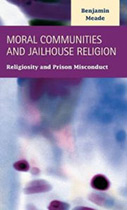Moral Communities and Jailhouse Religion: Religiosity and Prison Misconduct

Author: Benjamin Meade
Publisher: El Paso, TX: LFB Scholarly Publishing LLC, 2014. 244p.
Reviewer: Scott A. Desmond | September 2015
Although there has been a fair amount of research on how religious beliefs and practices can serve as protective factors against crime and substance use, especially among adolescents, there has been much less research on religion in the context of corrections. As Benjamin Meade, the author of Moral Communities and Jailhouse Religion: Religiosity and Prison Misconduct, points out, the lack of research on religion in the context of corrections is somewhat surprising, given the historical and contemporary influence of religion on corrections. Early prisons, for example, emphasized rehabilitation and reform through religious instruction and repentance (hence, the “penitentiary”). As the author notes, “rehabilitation, reformatories, reintegration and even the term ‘corrections’ itself are words that are related to the Christian ideas of conversion, salvation, and redemption” (p. 2). Religious influences are still readily apparent in modern correctional institutions, as prison chaplains provide religious instruction for inmates and contemporary prisons provide opportunities to participate in religious services, bible study, and other faith-based programs that are frequently staffed by volunteers associated with a religious organization.
Although existing research suggests that religion and participation in religious programs may be beneficial for inmates (e.g., by helping to alleviate the stress and loneliness of incarceration), the author argues that research has not established if religion or participation in religious programs reduces inmate misconduct in prison or offending after release. Meade argues that “many of the existing studies are of poor research design quality, conducted by individuals with little or no training in research methodology, or by individuals with a vested interest in the program(s) under study” (p. 3). Addressing important methodological limitations of previous research,, the author presents the results of two studies that fill important gaps in the literature on religion and inmate misconduct. First, Meade argues that the validity of previous research on religion and inmate misconduct is threatened by selection bias. That is, research that compares religious and non-religious inmates may be biased because the two groups are already fundamentally different in some way that influences misconduct. For example, religious inmates may have greater self-control, stronger moral beliefs, or be more motivated by guilt/shame to make amends for their crimes. Therefore, since inmates are not randomly assigned to be religious, any difference in misconduct between religious and non-religious inmates may be due to other unobserved differences between the groups, instead of religion. The author proposes to address the potential threat of selection bias with propensity score matching techniques that can be used to create statistically equivalent groups of inmates. The matched samples can then be compared to determine if inmate religiosity is related to misconduct.
Second, previous research suggests the effect of individual religious beliefs and practices, such as religious service attendance and religious salience, on deviance may depend on characteristics of the larger ecological context. More specifically, personal religiosity may have an effect on deviance only when people are embedded in some ecological context (e.g., neighborhood, school) with a high proportion of religious individuals. If surrounded by non-religious people, individual religiosity may not be salient in personal interactions and, therefore, may have no effect on involvement in deviant behavior. Inspired by previous research on the “moral communities” hypothesis, Meade wants to know if the effect of a prisoner’s religiosity on misconduct depends on the overall religious environment of the prison. The author proposes to address this question by examining the effects of prisoner religiosity, facility religiosity, and the interaction between the two on inmate misconduct using multi-level modeling.
Before proceeding to the analysis, in chapter 2 the author reviews the major theories that have been used to explain how religion can reduce deviance (e.g., social control, social learning, general strain theory, and the life course perspective) and summarizes the findings from previous research on religion and deviance. The author discusses several noteworthy hypotheses that have been developed to “make sense” of inconsistencies in previous research. For example, researchers have hypothesized that the relationship between religion and deviance is spurious, that religion has a stronger effect on drug and alcohol use than violent or property offenses (the anti-ascetic hypothesis), and that the effect of individual religiosity on deviance may depend on religious context (the moral communities hypothesis).
Similar to chapter 2, in chapter 3 the author reviews existing theory and research on inmate misconduct, which is often defined as “the violation of institutional rules by prisoners” (p. 39). After reviewing the dominant theories of inmate misconduct (deprivation theory, importation theory, and management theory) the author summarizes research on inmate-level (e.g., age, race/ethnicity, criminal history, sentence length, and inmate routines) and facility-level (e.g., security level, management style, and composition of inmate population) predictors of inmate misconduct.
In chapter 4, Meade presents a more in-depth discussion of history and the influence of religion on the development of American prisons, the potential benefits that involvement in religion may have for inmates, and examines studies that have specifically addressed religion and inmate misconduct. Meade argues that religion may contribute to desistance through the experience of a spiritual transformation. When discussing their spiritual transformations, the “desistance narratives” of inmates contain many common themes, such as spiritual growth, resisting the negative influence of the prison code, creating and maintaining a more optimistic outlook on life, and a desire to give back to society. In addition to desistance, inmates also have intrinsic and extrinsic motivations for participating in religion. Among the intrinsic motivations, religion may help inmates to cope with their loss of freedom, increase feelings of self-worth, deal with their guilt, and accept responsibility for their criminal behavior. As for extrinsic or instrumental motivations, participation in religious activities can provide more vulnerable inmates with a safe haven and access to goods or services that usually aren’t available to inmates, such as snacks, a telephone, music, and opportunities to socialize.
In chapter 5 Meade discusses the data and measures used to conduct the analysis. The author uses two different sources of data, the 2000 Census of State and Federal Adult Correctional Facilities and the 2004 Survey of Inmates in State and Federal Correctional Facilities. In total, the author examines survey responses from 9,841 male inmates housed in 194 state-operated facilities. The author examines both the self-reported prevalence and incidence of three types of inmate misconduct: assault, drug/alcohol misconduct, and other nonviolent forms of misconduct. Inmate religion is measured using a single yes or no item that combines many different religious beliefs and practices: “in the past week, have you engaged in any religious activities, such as religious services, private prayer or mediation, or Bible reading or studying?” (p. 99). Facility-level religiosity is measured by aggregating the individual-level measure of religiosity. Facility-level religiosity ranged from 25% to 89% of inmates in a facility engaging in religious activities in the past week. The author concludes chapter 5 with a discussion of propensity score modeling, used for study one, and multi-level modeling, used for study two.
Meade discusses the results of his two studies on religion and inmate misconduct in chapter 6. With regard to his study of selection effects, the author estimates how much selection bias may influence the results of research on religion and inmate misconduct by comparing the results of a “conventional regression” with the results from his analysis using propensity score matching. The results from the conventional regression models suggest that inmate religiosity is not significantly related to the prevalence of assault, drug/alcohol misconduct, or other nonviolent misconduct, and inmate religiosity is only related to the incidence of assault (not the incidence of drug/alcohol misconduct or other nonviolent misconduct). In contrast, the results from propensity score matching suggest that inmate religiosity is significantly related to both the prevalence and incidence of assault, but not the prevalence or incidence of drug/alcohol misconduct or other nonviolent misconduct. Given that there were few substantive differences between the results using conventional regression techniques and propensity score matching, the author concludes that “the effects of religiosity generated from a conventional regression may not be substantially biased” (p. 120).
With regard to his study of the moral communities hypothesis, similar to other studies that examine both individual-level and contextual-level effects, the author finds that most of the variation in the outcome (inmate misconduct) is at the individual-level (i.e., inmates), rather than the contextual-level (i.e., facilities). Between 74% (incidence of drug/alcohol misconduct) and 96% (incidence of other nonviolent misconduct) of the variation in misconduct is at the inmate-level, with much less variation (no more than 26%) at the facility-level.
When it comes to explaining the variation in the prevalence and incidence of inmate misconduct, Meade finds very few significant effects for either inmate religiosity or facility religiosity. At the individual-level, the results suggest that inmate religiosity is only significantly related to the incidence of assault. In contrast, inmate religiosity was not related to the prevalence of assault or the prevalence and incidence of drug/alcohol misconduct or other nonviolent misconduct. Facility-level religiosity was not significantly related to the prevalence or incidence of assault, drug/alcohol misconduct, or other nonviolent misconduct. Contrary to the moral communities hypotheses, the author did not find any cross-level interactions between inmate religiosity and facility religiosity (i.e., the effect of an inmate’s religiosity on misconduct did not vary or depend on the religiosity of the facility).
Although Meade concludes (chapter 7) that “religiosity had little effect on misconduct” (p. 133), the lack of significant results could be the result of data limitations. In particular, inmate religiosity is measured using a single yes or no item that combines many different religious beliefs and practices. Therefore, the author cannot disentangle the effects of different religious beliefs and practices (i.e., attendance at religious services, bible study, and prayer) on inmate misconduct. Also, since the measure only asks about religious participation over the past week, a very short time frame, responses may not accurately reflect the religiosity of inmates. Given that facility-level religiosity is measured by aggregating the individual-level measure of religiosity, the facility-level measure of religiosity is also less than ideal. Unfortunately, there are no items in the data that can be used to measure the availability of religious programing within a given prison. Despite the limitations in the measurement of religion, however, Moral Communities and Jailhouse Religion is a valuable contribution to the limited research on religion in the context of corrections. This book should appeal to anyone with an interest in religion and deviance and will hopefully stimulate additional research on inmate religiosity and the effects of participating in religious programs on inmates.
Scott A. Desmond, Instructor of Sociology, Indiana University Purdue University—Columbus


